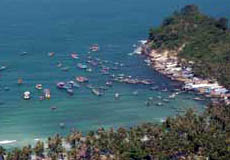The Nam Du archipelago is an undiscovered paradise off the southern coast of Vietnam.

It takes six hours for our small ferry to bounce over the waves to Cu Tron Island, 100km from the coastal city of Rach Gia in Kien Giang province in the southwest of Vietnam. Cu Tron is part of the Nam Du archipelago, a barely known set of islands that covers 40sqkm of land in the Gulf of Thailand.
There are 21 islands altogether, of which Cu Tron Island is the largest. Legend has it that the island was named by Lord Nguyen Anh, who sought safety here in 1870 after coming off second best in a battle with the Tay Son rebel army that had taken control of mainland Vietnam.
Lacking water, Nguyen Anh commanded his soldiers to dig a well, which is still there today on the northwest of Cu Tron Island by Ngu beach. Nguyen Anh and his troops were also short of food, so the locals helped them dig up yam to cook. When Nguyen Anh later took the throne as King Gia Long in 1802, he named the island Cu Tron, which means the island of the Round Yam, in memory of his tough times in exile. From the wharf you can walk along a three kilometre paved road towards the central town of An Son commune.
From there we head up into the hills and climb a mountain peak that provides a sweeping panorama view of the archipelago and beyond. We stand by the island’s lighthouse, staring down at the deep blue ocean which glistens in the brilliant sunshine. I can see the fishing villages and deserted beaches far below, which seem to call out to the explorers in us.
Inspired by the view, we descend down the mountain path, stopping by Ngu beach where we find Nguyen Anh’s historic well. There is only a smattering of houses around and the peace and quiet is almost hypnotic. We decide to rent a boat and take a trip around the archipelago. Down by the wharf we find a captain with a vessel who says he’ll take us for VND100,000. We sail around, passing some of the smaller islets off the coast of Cu Tron.
Most of these islets are rocky and rugged and uninhabited but Hon Mau is home to a small community and two striking white sandy beaches. We decide to take a closer look. The 200-hectare island is home to about 100 households who unsurprisingly live off fishing. The white sandy beaches slope gently to the sea. After hours of floating on the sea, we can’t resist taking a dip in the cool blue waters to take advantage of this hidden paradise – after all who knows when we’ll be back?
Afterwards we stop briefly on Mau Island, which is covered with thick green forest. Here there just 20 families living in thatched houses under the shade of coconut trees. It seems beyond idyllic but with nowhere to stay we have to press on to Ngang Island, which is the second largest island in the archipelago. Here thousands of fishing boats and boat-houses are anchored by the dock.
The island is much more crowded than Cu Tron though there are no vehicles running on the island. Neither are there actually any hotels, but you can crash at a local’s house for about VND20,000 to VDN50,000 per night in a sparsely furnished spare room. You won’t find a fancy candlelit restaurant nearby either, but local food stores or floating houses will cook up some fresh seafood and rice for you on request.
The locals are extremely friendly and hospitable and the food is amazing as long as you like seafood! While we feast on fish, sea snails, shrimp and crab, our host also offers us some handy advice on how to build a floating house, should we decide to relocate. When night falls, the sky and sea merge in the darkness and become a galaxy of twinkling lights and sparkling stars. We sit in silence on the bobbing floating house marveling at the simple beauty of this heavenly island.
How to get there: Currently you can only get to Cu Tron island by boat, which departs Rach Gia to Nam Du at 7.30am on Nguyen Cong Tru street every day. It takes five to six hours to get there. There are also two ferries connecting Ngang Island with Cu Tron Island departing at 7.30am and 3pm for VND10,000 person.